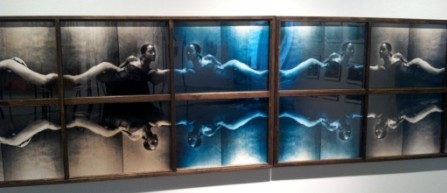Photos by Walter Burkat ‘16| The Lafayette
Creative freedom has supported the idea that art is an amorphous figure that cannot be defined by traditional standards. Thinking in unusual and eccentric ways defies the “limits” of art and thankfully, there are artists out there who are willing to test the boundaries of conventional thought.
EDGE VS. LINE, an exhibit hosted by the Grossman Gallery until September 27, seeks to test these boundaries by bridging the disconnect between the two-dimensional and three-dimensional. The display “contrasts two-dimensional and three-dimensional space in a variety of ways, exploiting the difference between the two kinds of space, and approaching a harmony that remains just out of reach,” says Grossman Gallery curator Elizabeth Johnson.
The exhibit brings together seven Lehigh Valley and two New York City artists. Artists such as Jamie Cabreza, Mike Cabreza, Gregory Coates, and Thom Cooney Crawford show off their work with paint, sculpture, photography, and the artistic utilization of everyday objects.
Jamie Cabreza, a native of Easton, uses photography to make seemingly simple scenes feel complex and meaningful. By using curbsides and gutters as “natural” borders, her photographs capture the essence of beauty in seemingly mundane places such as roadsides and sidewalks. As part of her signature style, Cabreza focuses her photographs on one aspect of the scene, such as a single penny on a walkway, or bird excrement on macadam. Her vernal memorialization captures the essence of the season and ensures that the moment lasts.
Jamie Cabreza’s husband Mike Cabreza is also an artist in EDGE VS. LINE – a photographer who seeks to develop symbolism is his works. His most notable piece, Belinda, is an assortment of photos in which a woman’s body has been “stretched” from one edge of the photo to another, and continues that same pattern across photographs. Her name, Belinda, is an amalgamation of the French word “belle,” meaning beautiful, and the German word “lind,” meaning serpent. The duality of the etymologies is evident in the duality of the piece, in which the photos are lined up in a fashion that resembles a reflection. Cabreza mentioned that this was supposed to create the illusion of a Rorschach inkblot test, which tests one’s internal perception.
EDGE VS. LINE even presents art apart from the conventional forms, such as paintings, sculpture, and sketches. Gregory Coates, of New York, challenges these methods and attempts to think outside the box. He is well known in the art-community for utilizing recycled bicycle inner tubes in his work, as they are malleable and easy to use.
“The less I do, the more honest I am,” Coates says of his work. His art is therefore naturalistic and untreated, letting the materials themselves do the talking. The work purposefully has less personal touch, so that there is minimal interference with material’s natural beauty.
Curator Elizabeth Johnson mentioned that she was “pulled into Coates’ process,” a pure and raw form of art which reminds viewers where the value of a piece lies. Rather than letting the artist determine the value of a piece, Coates’ excels in allowing the natural state of the art to have value in and of itself. Johnson predicts that Coates’ work will revolutionize the art world.
One of the most impressive artists uniquely incorporated a plot with his work. Thom Cooney Crawford, a native of Easton, creates sculptures inspired from his fascination with Greek mythology. In this exhibit, Crawford imagined his own “production” of the story of Orpheus. One of his sculptures tells the story of how Orpheus failed twice in rescuing his wife Eurydice, a tree nymph, from the Underworld. Another similarly exposes Eurydice, contorted in her agony as Orpheus fails to save her from the detriments of the Underworld. His structures continue in the theme of mythology, as another shows Orpheus’ face combined with the faces of Buddha and Oedipus, who respectively represent acceptance and the tragedy of blindness.
The Grossman Gallery summer gallery hours are 1:00-4:30 PM, Tuesday through Friday. The Grossman Gallery is located in the Williams Visual Arts Building on North 3rd Street.




































































































